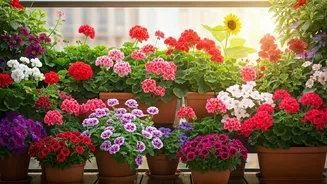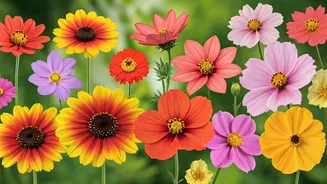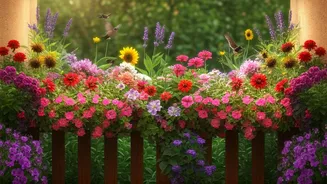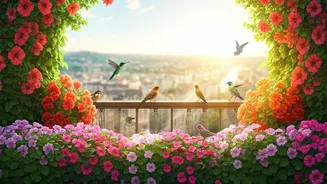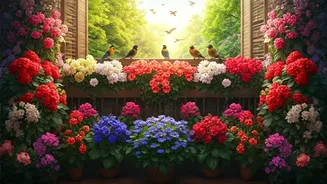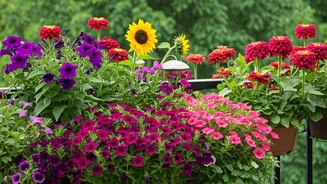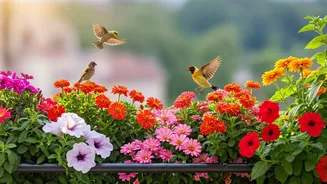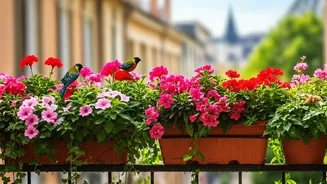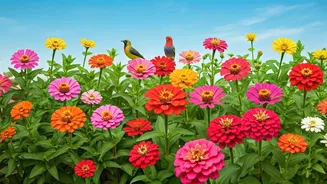Petunias: A Classic Choice
Petunias, with their trumpet-shaped blooms and a wide array of colors, are a favorite among balcony gardeners. These flowers are relatively easy to care
for, thriving in full sun and well-drained soil. They produce nectar that attracts hummingbirds and other small birds. Planting petunias in hanging baskets or containers allows them to cascade gracefully, creating a visually appealing and bird-friendly environment. Regular deadheading encourages more blooms, ensuring a continuous supply of nectar and a longer season of attracting birds. Petunias add a touch of elegance while supporting local birdlife. Their versatility in different settings makes them a great option for various balcony setups.
Marigolds: Sunny Delight
Marigolds are known for their bright, cheerful appearance and their ability to attract a variety of birds. These easy-to-grow flowers come in shades of yellow, orange, and red, adding a burst of sunshine to any balcony. Marigolds prefer full sun and well-drained soil. They are particularly attractive to seed-eating birds, as they produce seeds that serve as a food source. Their strong scent can also deter some pests, making them a practical choice for balcony gardens. Planting marigolds is a simple way to create a vibrant space and provide food for feathered visitors. The continuous blooms throughout the growing season provide a consistent source of seeds.
Zinnias: Bold and Beautiful
Zinnias offer a burst of vibrant color and are excellent for attracting butterflies, which in turn attract birds. These flowers come in many shades, including pink, purple, red, and yellow, adding a bold touch to any balcony garden. Zinnias thrive in full sun and well-drained soil. Their long-lasting blooms provide a continuous source of nectar for pollinators, thereby inviting birds. Regular watering and deadheading will encourage more blooms and extend their season of attraction. Planting zinnias creates a visually stunning display while supporting both butterflies and birds. They are relatively easy to grow from seeds or seedlings, making them a great choice for beginner gardeners.
Sunflower: A Towering Treat
Sunflowers, with their towering heights and bright yellow faces, are a fantastic choice for attracting birds, particularly seed-eating species. These plants provide a substantial food source once they mature and produce seeds. Sunflowers require full sun and well-drained soil. They can grow quite large, so ensure your balcony has adequate space. Planting sunflowers can create a dramatic focal point in your balcony garden, as they mature and open their seed heads. They offer a seasonal spectacle and a vital food supply for birds, especially during the colder months when other food sources become scarce. Choose dwarf varieties if space is a constraint.
Lantana: Butterfly Magnet
Lantana is a versatile plant that attracts butterflies with its vibrant, multi-colored flower clusters, and consequently, it draws birds that prey on insects. Lantana loves the sun and is drought-tolerant once established. It thrives in well-drained soil and provides a long season of blooms, keeping birds and insects engaged for extended periods. Pruning lantana regularly helps maintain its shape and encourages more blooms. Growing lantana adds a lively, colorful touch to the balcony and creates a mini-ecosystem, attracting various pollinators and the birds that feed on them. This makes it a great choice for creating a dynamic, bird-friendly environment.
Coneflowers: Purple Delight
Coneflowers, known for their daisy-like appearance and cone-shaped centers, are attractive to birds and pollinators. These flowers thrive in full sun and well-drained soil. They come in various colors, including purple, pink, and white, adding a graceful touch to any balcony. Coneflowers produce seeds that birds love to eat. Leaving the seed heads on the plants throughout the winter provides a valuable food source. Planting coneflowers offers a beautiful aesthetic and provides a crucial food supply during colder periods. Their ability to attract both butterflies and birds makes them a great option for promoting biodiversity in a balcony garden.
Nasturtiums: Edible Beauty
Nasturtiums are unique flowers, offering edible leaves and petals while attracting hummingbirds and other small birds. These flowers thrive in both sun and partial shade, making them suitable for different balcony conditions. They're easy to grow and come in various bright colors, adding a cheerful touch to the balcony. Nasturtiums prefer well-drained soil and don't require much fertilization. They act as a trap crop for pests, diverting them from other plants. Including nasturtiums provides a food source for both birds and humans. The versatility and ease of care make them perfect for adding a touch of edible beauty while supporting birdlife.
Bee Balm: Buzzing Attraction
Bee balm, with its vibrant, shaggy flowers, is a magnet for hummingbirds and other pollinators, creating an active and exciting balcony garden. Bee balm prefers full sun and well-drained soil, blooming from summer through fall. The flowers come in shades of red, pink, and purple, providing a stunning visual display. Bee balm has a unique, aromatic quality, adding a delightful fragrance to the balcony. This also attracts birds that feed on insects attracted to these plants. Planting bee balm ensures a bustling, dynamic environment, attracting birds and beneficial insects, creating an engaging ecosystem right outside your door.
Salvia: Hummingbird Favorite
Salvia varieties, especially those with vibrant red flowers, are a hummingbird favorite. These plants thrive in full sun and well-drained soil, offering a long blooming season. Salvia comes in various colors, providing versatility in balcony garden design. Their tubular flowers are perfectly shaped for hummingbirds to feed from, ensuring frequent visits. Planting salvia creates a lively display, attracting hummingbirds to your balcony. Regular watering and deadheading encourage prolonged blooming. They’re a relatively easy-to-care-for option for those wishing to draw in hummingbirds and add a dynamic touch to their balcony.
Pentas: Starry Blooms
Pentas, also known as Egyptian star clusters, are star-shaped flowers that attract butterflies and hummingbirds. These plants thrive in full sun and well-drained soil. They come in shades of pink, red, lavender, and white, making them a colorful addition to any balcony garden. Pentas provide a continuous source of nectar, drawing various birds and insects. Pruning spent flowers encourages more blooms, ensuring prolonged attraction. Growing pentas offers a stunning visual appeal and brings beneficial pollinators to your balcony. They contribute to a lively environment and create an engaging space that supports local bird and insect life.
